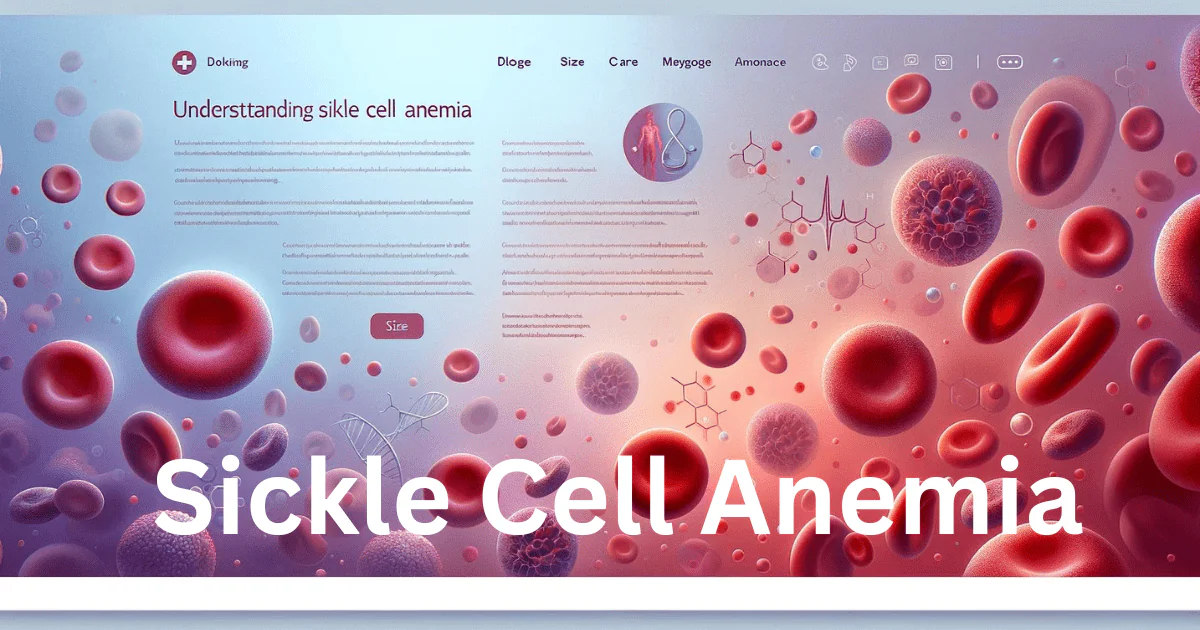Sickle cell anemia is a complex genetic disorder that affects millions worldwide. Understanding this condition is crucial for both patients and healthcare providers. Let’s delve into the intricacies of sickle cell anemia and why awareness is paramount.
Understanding Sickle Cell Anemia
Sickle cell anemia is a hereditary blood disorder characterized by abnormally shaped red blood cells. These cells, instead of being round and flexible, become rigid and crescent-shaped, resembling a sickle. This alteration in shape impairs their ability to flow smoothly through blood vessels.

The historical background of sickle cell anemia dates back to the early 20th century when it was first identified by Dr. James B. Herrick in 1910. Initially considered a rare disease, it gained significant attention due to its prevalence in certain populations, particularly those of African descent.
Genetic Basis of Sickle Cell Anemia
Sickle cell anemia is caused by a mutation in the gene responsible for producing hemoglobin, the protein that carries oxygen in red blood cells. This mutation leads to the production of abnormal hemoglobin known as hemoglobin S (HbS). When oxygen levels are low, HbS molecules can polymerize, causing red blood cells to deform and take on a sickle shape.
Symptoms and Signs
Common Symptoms
The symptoms of sickle cell anemia can vary widely among individuals. Common symptoms include fatigue, shortness of breath, and episodes of pain known as sickle cell crises. Other manifestations may include jaundice, delayed growth, and frequent infections.
Variability in Symptoms
The severity of symptoms can fluctuate depending on factors such as the type of sickle cell gene inherited and environmental influences. Some individuals may experience mild symptoms and lead relatively normal lives, while others may face more severe complications.
Potential Complications
Sickle cell anemia can lead to various complications, including acute chest syndrome, stroke, organ damage, and an increased risk of infections. Chronic complications such as kidney disease, pulmonary hypertension, and vision problems may also occur.
Diagnosis
Screening and Testing
Diagnosing sickle cell anemia typically involves newborn screening tests, which are conducted shortly after birth. Blood tests can confirm the presence of abnormal hemoglobin and determine the specific type of sickle cell disease.
Diagnostic Criteria
Criteria for diagnosing sickle cell anemia include the presence of characteristic symptoms, abnormal laboratory findings, and genetic testing to identify the specific hemoglobin variant.
Importance of Early Detection
Early detection of sickle cell anemia is crucial for implementing appropriate management strategies and preventing complications. Timely diagnosis allows for early intervention and comprehensive care to improve patient outcomes.
Treatment Options
Medications for Symptom Management
Treatment for sickle cell anemia aims to alleviate symptoms, manage complications, and improve quality of life. Medications such as hydroxyurea, pain relievers, and antibiotics may be prescribed to reduce pain, prevent infections, and decrease the frequency of sickle cell crises.
Blood Transfusions
In some cases, blood transfusions may be necessary to replace damaged red blood cells with healthy ones. Transfusions can help improve oxygen delivery to tissues, reduce the risk of complications, and alleviate symptoms.
Bone Marrow Transplantation
Bone marrow transplantation offers a potential cure for sickle cell anemia by replacing defective stem cells with healthy ones from a compatible donor. However, this procedure carries risks and is typically reserved for severe cases.
Managing Sickle Cell Anemia
Lifestyle Changes and Self-Care
Managing sickle cell anemia involves adopting a healthy lifestyle and making certain adjustments to minimize the risk of complications. This includes staying hydrated, avoiding extreme temperatures, getting regular exercise, and practicing good hygiene.
Importance of Regular Medical Monitoring
Regular medical check-ups are essential for monitoring the progress of sickle cell anemia and detecting any complications early on. Healthcare providers may perform routine blood tests, imaging studies, and other assessments to evaluate the patient’s condition and adjust treatment as needed.
Supportive Therapies and Services
Patients with sickle cell anemia may benefit from supportive therapies and services to address specific needs and improve overall well-being. This may include nutritional counseling, pain management techniques, psychological support, and access to social services.
Genetics and Inheritance Patterns
Understanding Genetic Transmission
Sickle cell anemia follows an autosomal recessive pattern of inheritance, meaning that both parents must carry a copy of the abnormal gene for their child to inherit the disorder. Individuals who inherit one copy of the abnormal gene are carriers, while those who inherit two copies develop the disease.
Genetic Counseling
Genetic counseling can help individuals and families understand the risks of passing on sickle cell anemia to their children and make informed decisions about family planning. Counseling sessions may involve discussing inheritance patterns, genetic testing options, and available support resources.
Family Planning Considerations
Family planning considerations for individuals with sickle cell anemia may include genetic testing, prenatal screening, and preimplantation genetic diagnosis to assess the risk of passing on the disorder to future generations. Counseling and support are essential for making informed decisions about reproductive options.
Epidemiology
Prevalence Worldwide
Sickle cell anemia is one of the most common genetic disorders worldwide, affecting millions of people, particularly those of African, Mediterranean, Middle Eastern, and South Asian descent. The prevalence of the disease varies geographically, with higher rates observed in regions where malaria is endemic.
Geographic Distribution
Sickle cell anemia is prevalent in regions with a history of malaria transmission, as the sickle cell trait provides some degree of protection against malaria infection. Countries in sub-Saharan Africa, the Middle East, India, and parts of the Mediterranean have the highest rates of sickle cell disease.
Ethnic and Racial Disparities
Ethnic and racial disparities exist in the prevalence and management of sickle cell anemia, with individuals of African descent disproportionately affected by the disease. Access to healthcare, socioeconomic factors, and cultural beliefs can influence outcomes and contribute to disparities in care.
Research and Advances
Current Research Efforts
Ongoing research into sickle cell anemia aims to improve understanding of the disease mechanisms, develop new treatment strategies, and find a cure. Studies focus on various aspects, including gene therapy, stem cell transplantation, and novel therapeutic agents targeting specific pathways involved in sickle cell pathophysiology.
Potential Therapeutic Breakthroughs
Recent advances in sickle cell research have led to promising therapeutic breakthroughs, such as gene editing techniques that aim to correct the underlying genetic defect responsible for the disease. Other approaches include fetal hemoglobin induction, anti-sickling agents, and interventions to prevent complications.
Future Directions in Treatment
The future of sickle cell anemia treatment holds potential for personalized therapies tailored to individual patient needs, improved access to care, and enhanced collaboration between researchers, healthcare providers, and patient advocacy groups. Continued investment in research and innovation is essential for advancing treatment options and ultimately finding a cure for sickle cell disease.
Living with Sickle Cell Anemia
Coping Strategies
Living with sickle cell anemia can present numerous challenges, but there are strategies individuals can employ to cope effectively. This may include adopting a positive attitude, seeking social support, practicing stress-reduction techniques, and maintaining a healthy lifestyle.
Psychological Impact
The psychological impact of sickle cell anemia can be significant, affecting mental health, emotional well-being, and quality of life. Patients may experience feelings of anxiety, depression, frustration, and social isolation due to the chronic nature of the disease and its associated complications.
Advocacy and Support Groups
Joining advocacy and support groups can provide individuals with sickle cell anemia and their families with valuable resources, education, and emotional support. These groups advocate for patient rights, raise awareness about the disease, and promote access to quality care and research initiatives.
Education and Awareness
Importance of Public Awareness
Raising public awareness about sickle cell anemia is essential for increasing understanding, reducing stigma, and promoting early detection and intervention. Education campaigns, community outreach efforts, and media initiatives play a crucial role in disseminating accurate information and dispelling misconceptions about the disease.
Advocacy Efforts
Advocacy efforts for sickle cell anemia aim to improve access to care, support research funding, and address disparities in healthcare delivery. Advocates work tirelessly to raise awareness, lobby for policy changes, and empower individuals affected by the disease to advocate for their needs and rights.
Addressing Stigma and Misconceptions
Stigma and misconceptions surrounding sickle cell anemia can contribute to discrimination, social stigma, and barriers to care. Education programs, cultural sensitivity training, and advocacy campaigns are needed to challenge stereotypes, promote acceptance, and foster a supportive environment for individuals living with the disease.
Global Health Implications
Challenges in Low-Resource Settings
Sickle cell anemia poses significant challenges in low-resource settings, where access to healthcare, diagnostic services, and specialized treatment options may be limited. Addressing these challenges requires a multifaceted approach involving government support, international collaboration, and community engagement to improve infrastructure, resources, and capacity for sickle cell care.
Strategies for Improving Access to Care
Efforts to improve access to care for individuals with sickle cell anemia include expanding screening programs, strengthening healthcare systems, and implementing evidence-based interventions at the community level. Sustainable strategies that address the root causes of health disparities and promote equitable access to quality care are essential for reducing the burden of the disease globally.
Collaborative Efforts in International Health
Collaborative efforts in international health are essential for addressing the global impact of sickle cell anemia and advancing public health initiatives. Partnerships between governments, non-profit organizations, research institutions, and community stakeholders can facilitate knowledge sharing, resource mobilization, and capacity building to improve outcomes for individuals affected by the disease worldwide.
Conclusion
In conclusion, sickle cell anemia is a complex genetic disorder that affects millions of people worldwide. Understanding the condition, its symptoms, diagnosis, and treatment options is essential for patients, families, healthcare providers, and policymakers alike. By raising awareness, advocating for better care, and supporting research efforts, we can empower individuals with sickle cell anemia and work towards a future free from the burden of this disease. Let us unite in our efforts to promote awareness, foster compassion, and support those affected by sickle cell anemia in their journey towards health and well-being.
Disclaimer : The information provided on this website/document is not a substitute for professional medical advice, diagnosis, or treatment. If you have any questions or concerns about your health, please consult with a licensed physician or other qualified healthcare provider.








